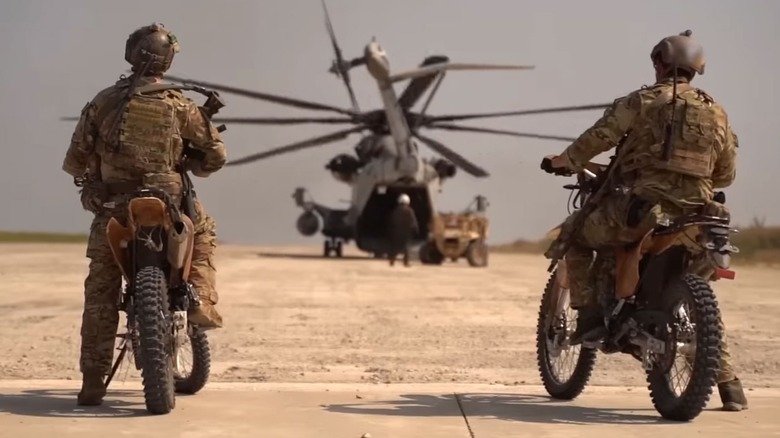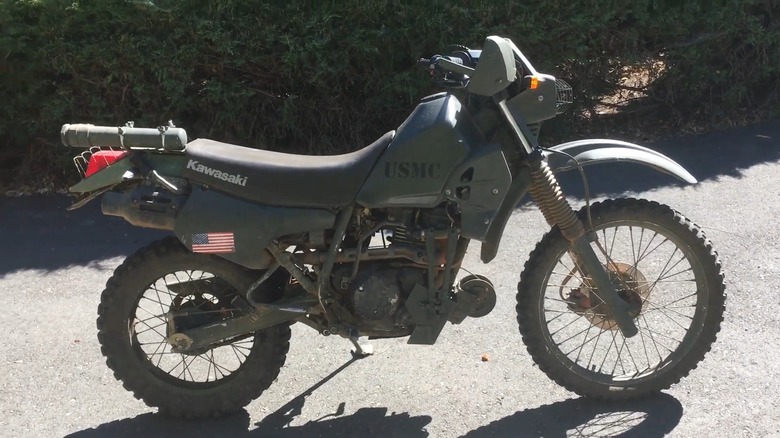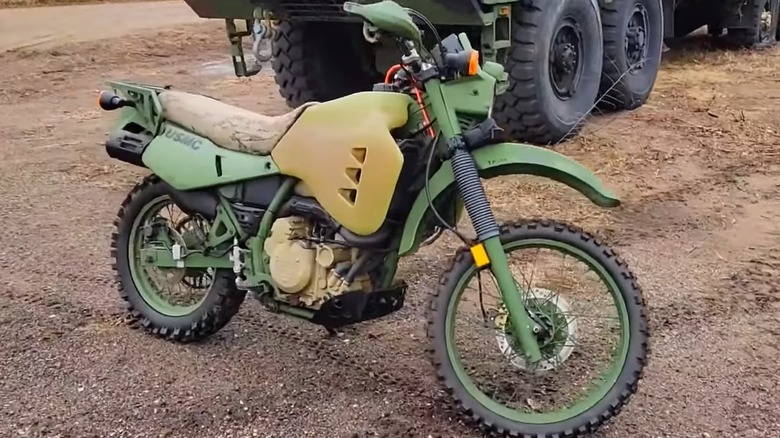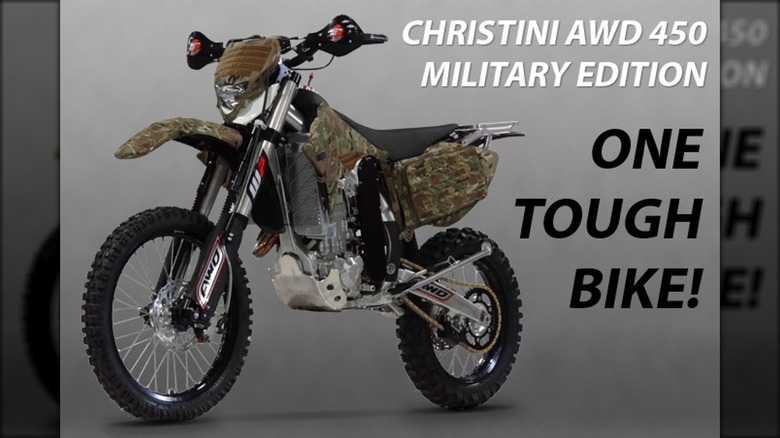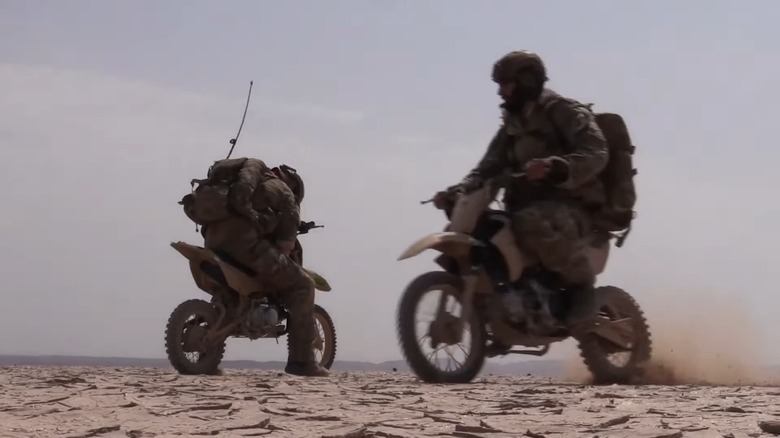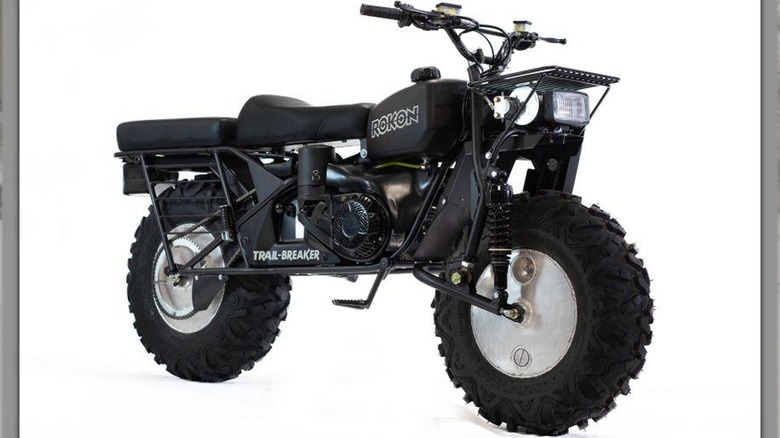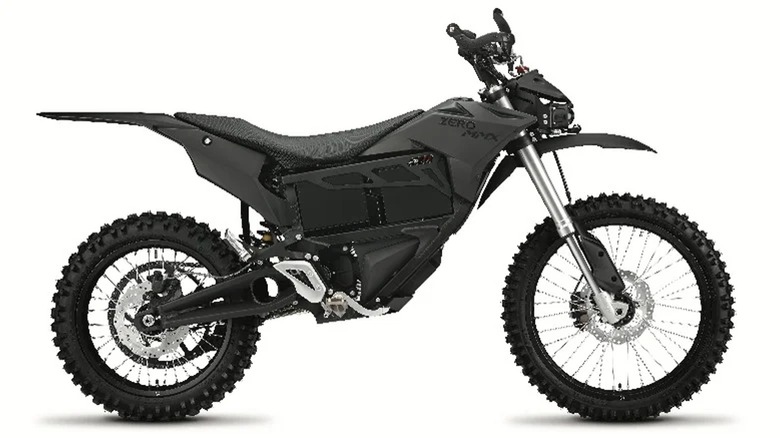These Motorcycles Power U.S. Military Special Ops—Here's What Makes Them Essential
The military has been using motorcycles in and out of combat operations since as far back as World War I. As conflicts developed with new technology, military motorcycles adapted and evolved. By WWII, motorcycles had become incredibly important vehicles used by all sides. The United States military has been using different model motorcycles for over a century, though most riders these days are members of Special Operations units like the Navy Seals, Army Special Forces, Marine Corps Raiders, Air Force Pararescue, and others.
Each branch and Special Operations Forces (SOF) unit uses a variety of motorcycles for different missions. Depending on the requirements, SOF personnel can bring along some of its most iconic military motorcycles for quick movement over rough terrain, zip around obstacles, or can be used for any number of mission needs. The motorcycles employed by U.S. SOF personnel are purpose-built or modified from pre-existing commercially available bikes, and they're easily transportable and stowable in helicopters and many land vehicles.
SOF motorcycles are also made without keyed ignitions, and they tend to sport appropriate camouflage based on where they're being used. During WWII, the U.S. military operated primarily American-made bikes like the 1942 WLA Harley Davidson or Indian 841, but no longer. These days, most bikes used by SOF personnel are from Japan with the bulk of models originating from Kawasaki, although there are other companies providing bikes to U.S. SOF. These are all the bikes currently employed by U.S. SOF, each of which brings something to the table.
Kawasaki KLR 250-D8
The Kawasaki KLR 250-D8 entered service in 1991 and has been employed by the U.S. Air Force, Marine Corps, and various SOF units ever since. These bikes were commercially available, and while they're technically dirt bikes, they are dual sport, making them street-legal in the United States. The version used by SOF personnel is close to its civilian counterpart, though it features some changes and modifications needed for combat usage, including the removal of the keyed ignition.
The bike weighs 295 lbs. and has a hardpoint on its rear for carrying cargo. Its range isn't as clear due to the different conditions the bikes are subjected to during normal military operations, though its gas tank can hold 2.91 gallons. In terms of power, the bike features a Kawasaki four-stroke single-cylinder engine capable of delivering up to 22.8 hp, enabling speeds of approximately 84 mph.
These bikes are used by Marine Expeditionary, Air Force Combat Controllers, and other units that need to move personnel quickly through an area. They're also used by members of the 75th Ranger Regiment, which uses them primarily for passing messages or working reconnaissance for scouting missions. Ranger Special Operations Vehicle (SOV) sections are the primary users within the regiment. Like all military motorcycles employed by the U.S., the Kawasaki KLR 250-D8 isn't armed, save for whatever firearms its riders may carry into combat.
Kawasaki M1030
While the U.S. military continues to use the Kawasaki KLR 250 model, Kawasaki replaced the KLR 250 series with the KLR 650 model, opening up new options for the force. These newer bikes are modified to run on JP-8 diesel fuel, giving them far more efficient fuel consumption — averaging 96 mpg. This makes them easier to deploy, as JP-8 is ubiquitous throughout U.S. military operations, as it's the primary fuel used during wartime for trucks, tanks, helicopters, planes, and some motorcycles.
The military's version of the bike is designated the Hayes M1020-M1, and it's been heavily modified by Hayes Diversified Technologies (HDT) for military use. Most of the bike remains, but HDT reduced the engines from 611cc to 584cc. It also features a new piston and other engine components that make it possible for the bike to reach speeds of 85 mph. Of course, the biggest advantage is its fuel economy, as the M1020-M1 has a range of 400 miles, which is impressive given its weight of 390 lbs. and relatively low hp of 28.
Since its introduction, a newer model has been made available, the M1030-M2 LE 670, which can run on seven fuel types, including JP-8. It utilizes a different engine, an HDT 670cc four-stroke, indirect injection liquid-cooled thumper. Each model is employed by the same branches and SOF units, including Marine Expeditionary, Army Rangers, Air Force Combat Controllers, and many others.
Christini AWD
When the U.S. entered Afghanistan as part of Operation Enduring Freedom, it was quickly apparent that SOF units required a certain type of motorcycle to navigate the hostile terrain used by pack animals and the like. Ultimately, they settled on the Christini AWD, which is a modified version of the company's Christini AWD 450 or 450 DS. To make it suitable for SOF use, Christini upgraded the bike with various add-on parts designed to aid in the bike's continued use in austere environments.
These bikes were used most often by the Navy SEALs, Army Special Forces, and other SOF units deployed in and out of Afghanistan. Christini sells a military version of this bike, though they are custom-made and cost $17,500 to $25,500 each, depending on the configuration and options. The Christina AWD is, as the name implies, an all-wheel drive motorcycle. It boasts a liquid-cooled 450cc four-stroke engine and was based on the Honda CRF450X.
Some of the modifications made to the bike to make it suitable for SOF use include added protection to the hands, the chain, and the radiator. These changes are meant to keep the bike operating for as long as possible. The bike can carry 2.3 gallons of fuel with an optional 1.5-gallon auxiliary tank available to bring that up to 3.8 gallons. They also feature a built-in GPS navigation system, though the one used by the military is different from what is available commercially.
Kawasaki KLX110
While some operations require more robust motorcycles to accomplish a task, others need something a bit smaller. For these missions, units like the Air Force's Special Operations Command Special Tactics and their Combat Rescue Officers use minibikes. One of the most used in this capacity is the Kawasaki KLX110. The bike is commercially available, but the one used by SOF units is modified to suit the mission requirements of those personnel.
Minibikes are even more transportable than full-size motorcycles and can be deployed via parachute to any location in the world. On top of that, the Kawasaki KLX110 can be fitted to the sides of MH-6 Little Bird helicopters, making them even more transportable. These bikes were used extensively in Afghanistan by U.S. SOF for a variety of purposes. In June 2017, they were used by Air Force SOF Airmen to construct a dirt landing strip for a C-130J Hercules — one of the largest planes in the U.S. inventory.
The bikes made it easier for the troops to move about, setting everything up in a very arid environment. Unsurprisingly, the bikes are on the small side, weighing 168 lbs. with a four-stroke single, Single Overhead Camshaft (SOHC), air-cooled 112cc engine. Regarding military modifications to make the commercially available bike useful for SOF, it appears the biggest alteration is to the bike's coloration, which ditches the standard bright green accents for a more drab camouflage coating.
Rokon Trail-Breaker
Most military missions require speed and maneuverability in their motorcycles, though that's not always the case. Sometimes, the terrain is too rough, or the mission requires something sturdier than your average two-wheeled conveyance. For those missions, U.S. SOF personnel look to the Rokon Trail-Breaker. This commercially available bike is known as "The Mountain Goat of Off-road," and if you look at its design, that's not hard to imagine. The Trail-Breaker features wide tractor tires measuring 8x12x25".
The tires are what give the Trail-Breaker the edge it needs to navigate any terrain the military may encounter. The bikes are also incredibly powerful and are able to climb a 60% grade and tow up to 2,000 lbs. Additionally, the hollow drum wheels are capable of providing floatation or holding an additional 2.5 gallons of water or fuel. Its suspension makes it easy for the Trail-Breaker to move over snow, mud, and loose sand, making it a sort of "Two-wheeled truck."
The Trail-Breaker's 208cc engine outputs 7 hp at 3,600 rpm, and the bike can go up to 35 mph. With a Trail-Breaker, you trade speed and maneuverability for the ability to navigate nearly any obstacle. This makes them ideal for SOF personnel operating in the mountains of places like Afghanistan. It's unclear how much the military modifies these commercially available beasts outside the paint scheme, but there's a good chance the keyed ignition was replaced, and other tweaks were made to ensure the bike's longevity in combat operations.
Zero MMX
One of the primary uses of motorcycles in the military is for reconnaissance. This makes sense, given how fast and maneuverable motorcycles are, but they're also rather noisy. Even if steps are taken to reduce the sound they make, motorcycle engines aren't quiet. That changed for SOF personnel in 2013 when Zero released the Zero MMX developed exclusively for U.S. SOF units. The selling point was its sound, or rather, lack thereof because the Zero MMX is an electric motorcycle featuring a quiet 54 hp motor.
It also features regenerative braking, so each time the brake is depressed, it feeds power back into the bike's battery. The Zero MMX also features a keyless ignition, quick-swappable power packs, a stealth headlight for nighttime operations, integrated wiring for infrared systems, and more. While the bike is incredibly quiet due to its electric motor, that same technology gives it a reduced heat signature, helping to mask the bike and its rider from infrared sensors.
The bikes weigh in at 276 lbs. and can reach 85 mph with a range of between 31 and 62 miles. In terms of range, they can handle between 60 and 120 minutes of "Aggressive tactical riding," depending on the model. These features make the Zero MMX an ideal motorcycle for reconnaissance operations. Granted, they're useful for a variety of missions, but it's hard to overlook a nearly silent bike when a rider needs to get a good tactical view of the battlespace.
